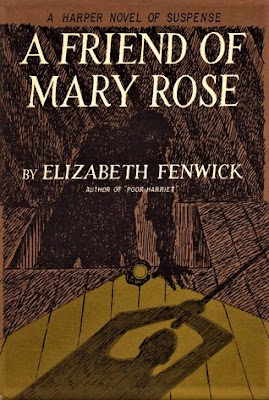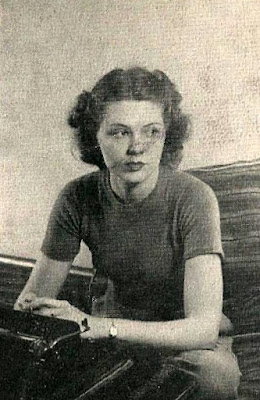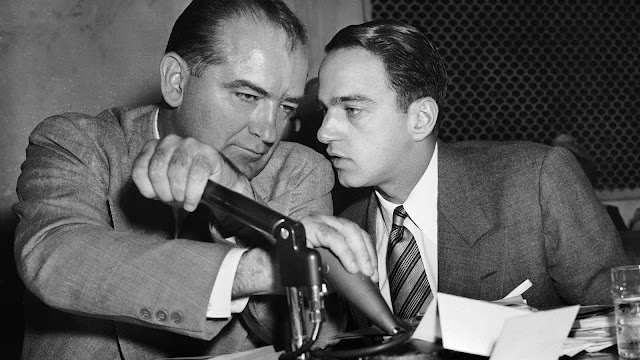One of the weird Patricia Highsmith stories you will read about her (besides the snail smuggling one or the one about how she drove sixty miles to purchase cheaper spaghetti) is how, when she briefly worked in the toy department at Bloomingdale's in the late 1940s, she became by her account instantly infatuated with a beautiful blonde woman customer who stopped there to buy a doll for her daughter. Highsmith looked up the woman's address and finding that it belonged to an affluent suburban New Jersey neighborhood went out there, where she stared at the woman's house, waiting for...what, exactly? This incident has led people to dub Highsmith a creepy spy and stalker, since she was, after all, stalking and spying upon the unsuspecting woman.
This queer encounter served as the immediate wellspring to Highsmith's celebrated lesbian novel, The Price of Salt (Carol), which the author published originally under a pseudonym in 1952, as anyone who has read the novel or seen the 2014 film based upon it would instantly recognize. Carol itself is not a crime novel but a love story, yet instances of spying and stalking crop up repeatedly in Highsmith's crime novels. These spiers and stalkers are men, with whom Patricia Highsmith routinely identified in her fiction and her life, even though she was intensely attracted to, and had numerous transient relationships with, women.
 |
| a rose for Annabelle the worm of reality eats away at an "innocent" obsession |
Men like David Kelsey in The Sweet Sickness, for instance, who cannot let go of his former girlfriend, Annabelle, who married another man while he, unbeknownst to her, had taken another job to make more money in order to marry her.
David simply refuses to accept the notion that a little thing like Annabelle's marriage should stand in their way. He writes her letters, even calls her, pestering her to divorce her husband, Gerald, and marry him. Even after he learns that Annabelle has given birth to Gerald's son, that still doesn't stop him.
David is a research chemist for a fabrics company in "Froudsburg," New York. Presumably the name is drawn from Stroudsburg, Pennsylvania, located in the Pocono Mountains about sixty miles north of New Hope, Pennsylvania, where Highsmith lived at the time with author Marijane Meaker.
At Froudsburg David resides at a boarding house during the weekdays, but he spends his weekends at a house in another locale which he purchased under the name William Neumeister, aka "New Master" in a bit of Nietzschean symbolism. As Bill Neumeister, David lives out a dream fantasy at the house with Annabelle as his wife, but he is determined to make this fantasy a reality. It is this determination which drives the novel toward its tragical destination.
If you read about Highsmith's life it's easy enough to see how much the character David is based on herself. Although Highsmith had numerous relationships with women, she was never able amicably to maintain one for more than a few years. She loved fantasizing about romantic relationships with women, but reality never seemed to live up to those fantasies, at least not for long. It's fascinating to see Highsmith with David Kelsey constructing this perverse, mentally disturbed character out of herself.
Aside from the fantasizing, the spying, the stalking, there's this sort of snobbery and elitism on David's part which appears to have been part of Highsmith's character as well, however misplaced. One of Highsmith's contemporaries, Patricia Schartle (her American agent at the time, who fired Highsmith as a client after two decades, when she was also the American agent of bestselling suspense novelist Mary Higgins Clark), recalled to Highsmith's first published biographer, Andrew Wilson, the "loneliness" in Highsmith, "a sadness in one so young." She was:
Gauche to an extreme....she felt a deep distrust of everything. She was totally secretive about her past....She tried to assume a superior European view...which was rather pathetic. Highsmith had absolutely no grace--poor woman, she thought having an expresso machine made her sophisticated.
Make of this what you will (Schartle had a bad falling out with Highsmith), but the expresso machine comment in particular struck me because, sure enough, sophisticated David Kelsey has an expresso machine! There's also a certain priggishness to David which people discerned as well in Highsmith, a quality seemingly incongruent with Highsmith's own promiscuity and sense that artists like herself were above conventional morality--except that we know there's a pronounced human tendency to live by a double standard, the one which one applies to oneself and the one which one applies to others.
Highsmith clearly understands that there is something deeply wrong with David, just as she worried about her own sanity and self-destructive behavior at times. However, she seems clearly to sympathize with him and she gets readers to sympathize with him too (at least she did this reader).
Highsmith paints a picture of a highly talented man, well-liked by the other boarding house residents, while his nemeses in the novel tend to be unappealing figures. Of course Highsmith stacks the deck because for the most part we only ever see these people through David's eyes. Over and over David describes Annabelle's husband Gerald as physically unappealing, for example, denigrating even his very masculinity ("That eunuch! For him to have married Annabelle was a piece of grotesquery--like a hunchback in a fairy tale capturing a princess.") As presented it indeed is hard to see what Annabelle ever saw in Gerald. All Annabelle can ever say is she is married to him now and she has had his baby and that's that.
It's actually rather hard to see, for that matter, quite the appeal of Annabelle, except that she's pretty. David thinks and talks about her classical piano playing before her marriage and this book she wanted to write on composers, but Annabelle seems to have no interest in any of this anymore, ever since she married, speaking only of her domestic duties of child care and housekeeping. Highsmith had contempt for women who allowed themselves, as she saw it, to be extinguished by marriage and childbearing, and that attitude is reflected in David's view that Annabelle is no longer living up to her potential and needs him to rescue her and make her whole. In her baby he takes no interest whatever, failing even to remember whether the creature is a boy or girl.
Annabelle really comes off as a wet noodle, failing to break things off decisively with David. She reminds me of those conflicted married women with whom Highsmith had affairs. It's indicative of the gravity of David's delusion that he has elevated this rather dull and conventional vessel to the status of a rarefied fairy princess. Highsmith might well be commenting on her own tendency to romanticize women in her fantasies.
Then there are David's "friends," Wes Carmichael and Effie Brennan. Wes is a co-worker in a bad marriage with a compulsive housecleaning shrew named Laura (we never actually meet her, so have to rely on Wes and David for impressions of her), while Effie is a secretary who pathetically chases after David, who patently has no interest in her whatsoever.
I actually found Effie the least appealing character of the many unappealing characters in this book. Certainly David's view of Effie does her no favors, yet though her own actions she herself comes off as a spy and stalker, pursuing David, whom after but a short time she announces she's "in love" with, in that horrific passive-aggressive, masochistic fashion of so many women in mid-century novels. Through her ill-advised invasiveness of David's space she triggers many of the novel's disasters. If Effie is the only alternative woman this novel presents us, no wonder, we are tempted to think, that David pursues Annabelle, as wet as she is.
Contrast Annabelle and Effie with the elderly, nonsexual Mrs. Beecham, one of the residents at the boarding house, who functions as a sort of surrogate mother to the orphaned David. In actuality she is sixty years older than David, so she is more a grandmother, recalling Highsmith's own maternal grandmother, Willie Mae Coates, who died, several years before Highsmith started writing This Sweet Sickness, at the age of eighty-eight, the same age as Mrs. Beecham in the novel.
After Highsmith's parents broke up (Highsmith later claimed she fantasized about murdering her stepfather, from whom she derived her surname), she lived for a time with her grandmother, who, it just so happens, ran a boarding house in Fort Worth. Her relationship with her grandmother was much better than the one she experienced with her own mother, which can fairly be described as dysfunctional and ultimately disastrous.
Coincidences? I think not. In any event, David's relationship with kindly Mrs. Beecham is a lonely beacon of genuine human affection in this sad novel. As an aside I might add that the boarding house setting, while unsentimentally presented, is cozy enough that it could have appeared in a classic detective novel.
 |
| love is like vertigo |
As I type these words I find myself thinking, what is this piece even doing on this blog? Because it feels like what I am describing is a straight novel. There is crime in this book, serious crime, but it's accidental and almost incidental, in a way, to a sophisticated study in morbid psychology. It's like Conrad Aiken's incisive 1934 short story about schizophrenia, "Silent Snow, Secret Snow," except there's a body count.
Highsmith followed Sickness a couple of years later with another, rather similar novel, The Cry of the Owl, and then she began drifting more and more way from straight crime fiction into the direction of mainstream lit, giving fits to her publishers, who had trouble placing her into one of their tidy, little boxes.
Personally, I would say that the heart of Highsmith's true contribution to crime fiction comes from the Fifties, in such books as Strangers on a Train, The Talented Mr. Ripley (her two most famous novels), The Blunderer, Deep Water and even the generally poorly regarded A Game for the Living. I noticed that influential crime fiction reviewer Anthony Boucher often seemed pretty apathetic to Highsmith's work, frequently complaining about its length. Here he is on Sickness, after admitting that it was "an impressive psychological study":
The book has the compulsion of truth; and probably only a professional reviewer in a heavy season would protest that she might have got the same results in something under 100,000 words.
By my estimate Sickness is only about 83,000 words (anyone have a better idea?), but obviously it felt like 100,000 to Boucher. He has a point too. Until its' last fifty or so pages, the 250-page book is a slow burn. Is it even a "thriller"? Arguably the "digressions" which make it a great character study undermine it as a crime thriller, but I wouldn't want to lose them.
It's Highsmith's willingness to go to the darker recesses of the heart and mind and not ever let much light in that makes her such an interesting writer and quite an exceptional figure for the genre in her day, especially among women. There's been much talk lately about mid-century domestic suspense (some of the talk from me), but Highsmith stands apart from her sisters, both in not being very domestic and in being less confined by conventions of the day. Even a contemporary lesbian crime writer like Ruth Fenisong doesn't bear much resemblance to Highsmith, whose writing was as unique as the author herself.






















